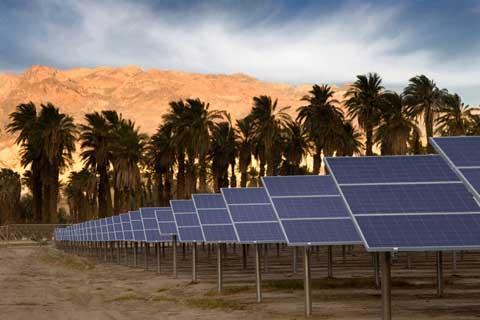There's been a lot of discussion in our country recently about alternative energy, and whether or not solar, wind and other high-tech sources of power are really practical. If you were assigned the job of selecting a national park in the United States where solar energy could reduce consumption of electricity from traditional energy sources in a meaningful way, which park would be your first choice?
When it comes to potential for solar power, you'd be hard-pressed to find a better location anywhere on the planet than Death Valley National Park. You may live in an area where staying cool in the summer requires a lot of electricity, but I suspect this piece of the California desert has just about everyone else beat for serious summer heat.
One key question remains—can usable amounts of solar power be produced without undue intrusion on park views and resources?
The good new is… at Death Valley, the answer seems to be "yes." One of the largest privately-owned PV (photovoltaic) energy systems in the country was installed earlier this year by Xanterra Parks & Resorts, the park concessioner that operates the Furnace Creek Inn and Furnace Creek Ranch.
The one megawatt system is big—it covers an area larger than five football fields—so it was installed in the middle of an existing developed area and is screened by vegetation. The solar plant is expected to generate more than one-third of the total annual electricity needs of Xanterra's operations in Death Valley by producing more than two million kilowatt-hours (kWh) of electricity per year. That's enough to power more than 400 average-sized American homes.
I spoke by phone with Chris Lane, Xanterra's vice president of Environmental Affairs, to find out how the system is doing after its first summer of operation. He's enthusiastic about the results, and says they are on track to generate 2 million kWh for the first year. During mid-day in the summer, the system has produced as much as 75 percent of the total electric power used by the company's Furnace Creek facilities.
The system tracks the sun throughout the day and was designed to withstand the harsh conditions of Death Valley. The electricity feeds directly into the electric grid instead of into batteries.
What do visitors think about the idea? I spoke with a ranger in the park's interpretation division, who said they had received a "lot of positive comments," and he hadn't heard any negative feedback. The solar facility itself has become something of an attraction, and Xanterra has constructed a viewing platform so the public can get a better look.
Some pundits around the country have questioned the economics of "green" energy, but this company seems sold on the idea.
"Xanterra is exceptionally proud of this system because it illustrates what one company can do with a systematic environmental program and a long-term approach to sustainable operations," said Andrew N. Todd, president and CEO of Denver-based Xanterra. "It also proves that doing the right thing environmentally can make good business sense. The project is fiscally viable. With the savings on energy costs, we expect to break even in just a few years."
Let's hope that other companies—and the politicians who fund park facilities—are paying attention.




Comments
Thanks to all of you who are interested enough in this topic to comment! (We also appreciate it when the discourse remains civil :-)
My article wasn't intended to be a commentary on the pros of cons of Xanterra - or any other company - but rather an example of what I feel is a positive step in using alternative energy. Perhaps this project will encourage similar efforts in both the private and public sector.
I´ve been working as biologist in natural areas for 10 years in Brazil, and always thinking in similar initiatives in our country whom is blessed of sun during the year.
I would like to known about agencies that sponsor similar projects in South America, especially to conservation areas.
Thanks!
This is a very good idea. People can enjoy the benefits of installing solar panels in different parks and open spaces.